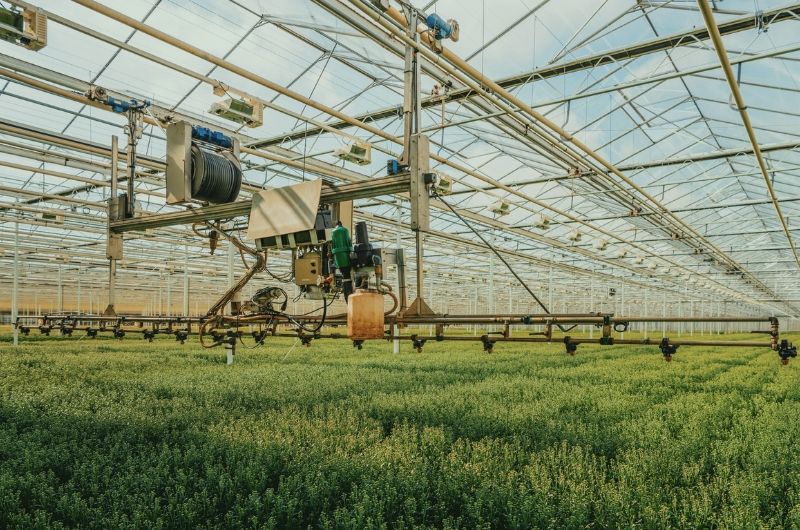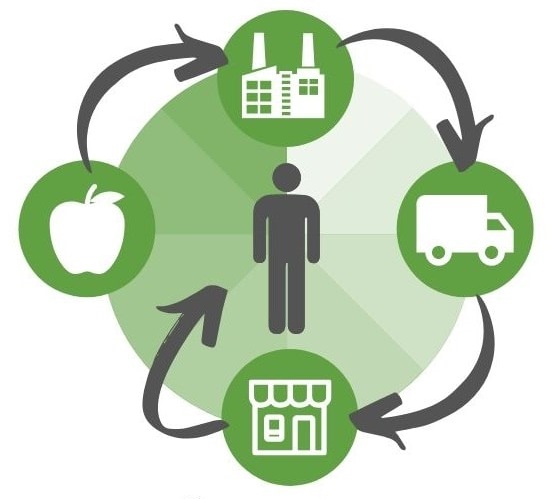
How can blockchain technology transform the food industry?
- With the help of Blockchain, customers can receive almost immediate information about the product that they are purchasing.
- Blockchain has the potential to “Uberise” the agrifood industry by lowering transaction costs and eliminating middlemen.
- Louis Dreyfus Co., a trading house based in the Netherlands, completed the first-ever agricultural trade using Blockchain in 2017 selling soybeans to China.

A three-course meal was traced entirely from the farm to the fork using an in-production Blockchain…
Did you know that blockchain was a driving force behind the popularity of Bitcoin? In addition, the blockchain revolution is not only limited to cryptocurrencies but can also be applied in various other industries, such as the food industry. This happened for the first time ever in 2018 when a three-course meal was traced entirely from the farm to the fork using an in-production blockchain – and this is just the start.
What is the blockchain?
The blockchain refers to a digitalised, dispersed spreadsheet that records transactions and tracks assets in a business network. The assets could be tangible or intangible in nature. Since these assets are distributed by the countless number of computers in the business network worldwide, they cannot be controlled by a single person. Instead, when a person uploads a transaction to the network, the systems run complex algorithms to check if the transaction is valid. If this transaction is binding, it is linked to the preceding transaction. This set of linked transactions is the blockchain. It is known as the blockchain because the transacted data is stored in blocks, which when combined, form a chain.
Blockchain consists of three key concepts:
- Shared ledger: transactions are only recorded once in the shared ledger, removing the confusion caused by duplication. This concept has a few characteristics:
- It records all transactions;
- It is shared among all the blockchain participants, but their copies of the ledger are duplicated;
- The participants in the network can only view those transactions for which they have authorisation.
- Permission: this feature of blockchain is what makes it really popular for network implementation. It has the power to prevent certain participants from viewing specific transactions if they are not authorised to.
- Consensus: transactions in the blockchain can be verified in the ledger through consensus. This is only applicable to those people in a network who can be trusted.
Who are blockchain participants?
- Blockchain user: these are people who join the blockchain network and carry out transactions with other users.
- Regulator: this is a user who has obtained special permission to supervise all the transactions occurring in the network.
- Blockchain developer: these are the people who create the applications and the network on which the transactions occur and are stored.
- Blockchain network operator: these consist of the people who have the authority to outline, form, manage and observe the blockchain network. There is a network operator assigned to each blockchain business network.
- Certificate authority: this includes those people who hand out and manage various certificates that are required for the running of a specific blockchain.
How does blockchain work?
The process begins when a new transaction or an edit to an existing transaction is recorded in the blockchain. This is followed by multiple computers or nodes implementing algorithms to analyse the authenticity of the transaction and the history of the individual who recorded the transaction. If no red flags arise at this stage, these transactions are accepted into the ledger and a new block is added to the pre-existing set of linked transactions. On the other hand, if some issues regarding the transaction happen to appear, it is not added to the ledger and therefore to the chain.
Blockchains are versatile and can be structured in several different ways. The method employed depends on the objective to be achieved.
In addition to being versatile, blockchain has other benefits, including:
- Reduces expenditure: blockchain helps in reducing expenses by:
- Removing intermediaries so participants can trade valued items directly;
- Decreasing the amount of supervision time as the network is already self-policed by the blockchain participants;
- Reducing duplication efforts.
- Saves time: it helps in reducing the time taken for complex transactions from days to minutes. The transaction settlement is also sped up as verification by a central authority is not required.
- Greater security: blockchain has stringent security measures, protecting the transactions and information against cybercrime, tampering and fraud.
- Better privacy: due to the presence of IDs and permissions, users can choose which transaction details they want other participants to view.
- Increases auditability: since only a single ledger is present, it has helped to monitor the transactions with ease.
- Greater operational efficiency: it helps in tracking the movement of assets through a supply chain, thus streamlining the transfer of ownership.
Imagine you could trace the source of your food in seconds…

Transforming the food industry using blockchain technology
Imagine you could trace the source of your food in seconds or if you could check if the fruits you purchased were actually organic. This could actually happen in the near future, with blockchain set to make its debut in the food industry. Blockchain can help in many ways through:
- Food safety: blockchain helps in making the food supply chain transparent and also empowers the chain to be aware of any food safety disasters. This is one of the reasons why organisations like Unilever and Nestle are considering employing blockchain technology. By using it, consumers would be able to trace the origins of certain products to prove its authenticity.
- Preventing fraud: it would also help in preventing fraud, if the data collected is free of any human error. Collected data is often vulnerable to hacking, inaccuracies and errors. Implementing blockchain would help in preventing these issues. It would also help in identifying the culprit if an error is made. For instance, it would prevent the kind of food fraud that happened in Canada in 2016.
- Easier and faster payment: blockchain would speed up the payment process. It would assist farmers in selling more and being compensated properly as the market data would be at their fingertips. It could also prevent the occurrence of retroactive payments and price coercion. According to Forbes, blockchain could ‘Uberize’ the agrifood industry by reducing transaction fees and removing intermediaries.
Blockchain also benefits the players in the food supply chain process in the following manner:
- Producer: blockchain helps producers in detecting any alterations to the products are being made. This is also applicable to the distributors.
- Distributors: if any damaged product ends up on sale, they can be easily recognised and removed with the help of blockchain.
- Consumer: the presence of blockchain in the entire process increases the consumers’ trust in the producers and distributors as the products are labelled with the correct information.
Benefits of using blockchain in supply chains
- Reduces fraud in the supply chain process: since blockchain detects altered transactions in the network, product counterfeiting will be automatically reduced or eliminated in this process.
- Transparency and trust: since the data present in blockchains can be shared between multiple parties, it creates a transparent process. It also helps in building trust between the parties.
- Reduction in paperwork: blockchain also helps organisations in reducing their paperwork. According to Skcript.com, MAERSK employed a Hyperledger based blockchain that helped in reducing paperwork by over 15%.
- Easier inventory management: as blockchain makes use of Distributed Ledger Technology (DTL), it is easier to manage the inventory since the information is present with everyone.
- Greater security: as blockchain has strict security procedures, the information that is present in the supply chain process is made confidential.
Use and optimisation of blockchain largely depends on market dominance, regulatory factors and, ultimately, the honesty of the blockchain writer. There is the ability to check verification of the blockchain writer, but fraudulent data can be written and remain undetected. Ultimately, blockchain implementation is a strategic business decision that requires careful analysis of the pros and cons within the context of each organisation.
GISMA Business School offer a range of programmes. Enquire now for more information.